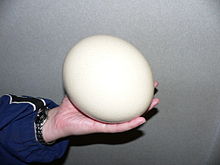Ostrich females lay their fertilized eggs in a single communal nest, a simple pit, 12–24 inches deep and 9.8 feet wide, scraped in the ground by the male. Ostrich eggs are the largest of all eggs.
On average they are 5.9 in. long, 5.1 in. wide, and weigh about 3.1 lbs., over 20 times the weight of a chicken egg. They are glossy cream-colored, with thick shells marked by small pits. Their thickness of approximately 1/8 in. allows for dimensional carving.

